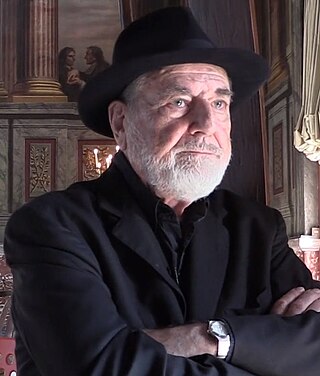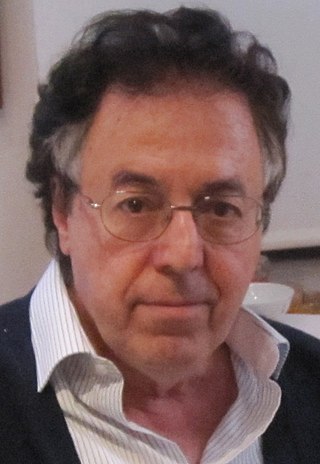
Arte Povera was an art movement that took place between the end of the 1960s and the beginning of the 1970s in major cities throughout Italy and above all in Turin. Other cities where the movement was also important are Milan, Rome, Genoa, Venice, Naples and Bologna. The term was coined by Italian art critic Germano Celant in 1967 and introduced in Italy during the period of upheaval at the end of the 1960s, when artists were taking a radical stance. Artists began attacking the values of established institutions of government, industry, and culture.

Jannis Kounellis was a Greek Italian artist based in Rome. A key figure associated with Arte Povera, he studied at the Accademia di Belle Arti in Rome.

Museo de Arte de Ponce (MAP) is an art museum located on Avenida Las Américas in Ponce, Puerto Rico. It houses a collection of European art, as well as works by Puerto Rican artists. The museum contains one of the most important Pre-Raphaelite collections in the Western Hemisphere, holding some 4,500 pieces of art distributed among fourteen galleries.
Susana Medina is an English-Spanish writer.

Alighiero Fabrizio Boetti known as Alighiero e Boetti was an Italian conceptual artist, considered to be a member of the art movement Arte Povera.
Rocio Urquijo was a Spanish artist and first wife of Filipino industrialist Enrique Zobel.
Luciano Fabro was an Italian sculptor, conceptual artist and writer associated with the Arte Povera movement.

Michelangelo Pistoletto is an Italian painter, action and object artist, and art theorist. Pistoletto is acknowledged as one of the main representatives of the Italian Arte Povera. His work mainly deals with the subject matter of reflection and the unification of art and everyday life in terms of a Gesamtkunstwerk.

Elena Ochoa Foster, Lady Foster of Thames Bank is a Spanish publisher and art curator, and formerly a professor of psychopathology. She is the founder and chief executive officer of Ivorypress.

Lina Dorado is a contemporary artist and filmmaker based in New York City noted for her multimedia work and travel photography, Lina Dorado has authored two books in bilingual editions: Doble Vista / Second Sight and Drawing Only, Solo Dibujo alongside her long-term collaborator: Luis Cantillo. Their book Doble Vista / Second Sight written by Dorado and photographs by both was acquired by the New York Public Library Museum of Modern Art in New York MOMA and the Whitney Museum for their Artists' Books Collection. In August 2018 her first feature film Pelucas y Rokanrol was theatrically released in Colombia, the film was directed by Mario Duarte and written by Mario Duarte and Lina Dorado.
Marisa Merz was an Italian artist and sculptor. In the 1960s, Merz was the only female protagonist associated with the radical Arte povera movement. In 2013 she was awarded the Golden Lion for Lifetime Achievement at the Venice Biennale. She lived and worked in Turin, Italy.
Alejandro Gonzalez Gortazar is a Cuban photographer, visual artist, journalist and entrepreneur working in London, United Kingdom since 2009. Gortazar's photographic work has focused on nature, and wildlife and the environment. His photographs are sometimes mistaken for paintings.

Guillem Ramos-Poquí is a painter who was a major figure of Arte Povera and Conceptual art in Catalonia during the 1960s. He has lived in London since 1968.

Sandra Monterroso is a Guatemalan visual artist and designer. Art historian Virginia Pérez-Ratton writes about Monterroso's beginnings as a performance artist in Guatemala during 1999 and 2000. Alongside her were other Guatemalan female performers like Regina José Galindo, Maria Adela Díaz, and Jessica Lagunas. Recently Monterroso's work focuses not only in performance art. She works with different media such as video art, installations and mixed media. Her work is related to power structures, gender issues and decolonial thinking. Her work is also included in the Artist Pension Trust.
Gianni Piacentino is an Italian artist known for his sculpture and painting inspired by motorcycles, automobiles and planes.

Andrés Waissman is a visual artist born in Buenos Aires, Argentina, in 1955. A relevant figure of Argentinian and Latin-American contemporary art, he is known for paintings such as Multitudes, Black & White, and his most recent work, Virutas. He lives and works in Buenos Aires.
Eva Raboso is a Spanish abstract neo-expressionist cinematic artist. Eva Raboso has paintings exhibited at Venezzia Biennale The Fall of the rebel angels, Spain, Frieze Qpark Cavendish at London, Madrid and many others. Also, her works are present in collections international galleries and collections like (london) Le Dame gallery or (Madrid) David Bardía gallery.

Delia Cancela is an Argentine pop artist and fashion designer. She has lived in Argentina, New York, London and Paris, and exhibited internationally. Retrospective exhibitions of her work and her collaborations with Pablo Mesejean include Delia Cancela 2000-Retrospectiva (2000), Pablo & Delia, The London Years 1970-1975 (2001), and Delia Cancela: una artista en la moda (2013).

Chiara Passa is a visual artist working in media art since the second half of the 1990s.

Yolanda Domínguez Rodríguez is a Spanish visual artist, activist, and journalist.













